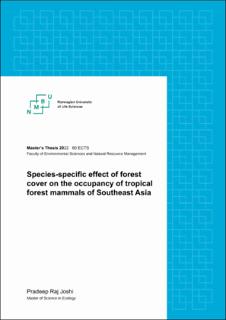| dc.description.abstract | Tropical forests harbour more than half of the world’s biodiversity and 63% of the world’s terrestrial mammals. Today this biodiversity is under threat due to habitat loss and degradation by human activities. This makes tropical mammals vulnerable as mammals are very sensitive to changes in their habitat. In this regard, protected areas are critical for the conservation of tropical biodiversity including mammals because they are the core refuge and the best remaining habitats for many threatened mammals. Protected areas, however, are not unaffected by human activities and the forest cover within them is not uniform. How does forest cover relate to the occupancy of mammals in tropical protected areas? Do these relationships vary among species and/or groups of species? In this study, I analysed mammal occurrence and forest cover relations in tropical protected areas of Southeast Asia, and how these responses are modulated by species-specific functional traits.
I used systematic camera trap data of 2013/2014 from the TEAM (Tropical Ecology Assessment and Monitoring) Network. I analysed a total of 45,182 photographs of 37 mammal species captured through 4,178 trap days. First, I fitted single-season single-species occupancy models to assess the relationship between occupancy and forest cover. Second, I used the parameter estimates for forest cover and species’ functional traits to understand how the occupancy-forest cover relations are governed by the species’ functional traits.
The occupancy analysis resulted in 12 species whose results can be interpreted. I found a positive association between forest cover and occupancy. Although insignificant, there were variations in these associations across species and species groups and were defined by forest specialisation and the feeding guild of the species. Forest specialists and carnivores/omnivores had stronger and more positive associations than non-specialists and herbivores/insectivores. Because these forests are tropical protected areas, the lack of pronounced and clear effects suggests that there may not be enough variation in forest cover to observe differences in response. Furthermore, efforts to conserve biodiversity in these areas may still be effective. Using multiple years’ data and following alternate statistical approaches of occupancy modelling and parameter estimation is recommended for future studies, to overcome the issues with sparse data. | en_US |

